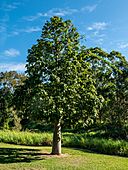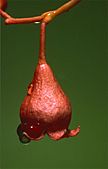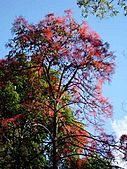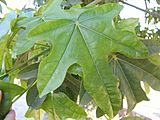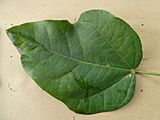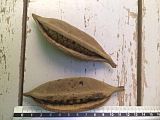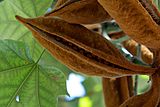Flame tree facts for kids
Quick facts for kids Flame tree |
|
|---|---|
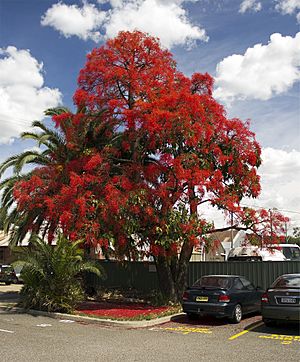 |
|
| Conservation status | |
|
Least Concern (NCA)
|
|
| Scientific classification | |
| Genus: |
Brachychiton
|
| Species: |
acerifolius
|
| Synonyms | |
|
|
The Brachychiton acerifolius is a large tree often called the Illawarra flame tree. It belongs to the Malvaceae family, which also includes hibiscus and cotton. This tree grows naturally in tropical and subtropical parts of eastern Australia.
It's famous for its amazing bright red, bell-shaped flowers. These flowers often cover the entire tree when it has lost its leaves. People also call it the flame tree, lacebark tree, or kurrajong.
Contents
What Does the Flame Tree Look Like?
This tree is a large deciduous tree, meaning it sheds its leaves. It usually grows in a pyramid shape. In its natural home, it can reach up to 30 to 35 meters (about 100 to 115 feet) tall. When grown in gardens, it is usually a bit shorter.
The trunk is smooth and can be green or grey-green. It often tapers, getting narrower towards the top. The leaves are shiny green and can be quite large, up to 30 cm (12 inches) long. They have long stems and can be different shapes, from oval to having up to five lobes, like a hand.
Flowers and Fruits
The flowers are bright red or scarlet. They look like bells from the side and stars when you look at them head-on. Each flower is about 2.5 to 3 cm (1 to 1.2 inches) long. They grow in large clusters.
After the flowers, the tree produces dark brown, leathery pods. These pods are shaped like a boat and are about 10 cm (4 inches) long. They ripen around May to August in Australia. When ripe, they split open on one side. Inside, there are 12 to 26 yellow seeds. Each seed is about 1 cm (0.4 inches) long. They are surrounded by papery, stiff hairs. Be careful, these hairs can be very irritating if you touch them!
Where Does the Flame Tree Grow?
The Illawarra flame tree is found in lush coastal rainforests. It grows from southern New South Wales all the way to far north Queensland. In places like Cape York Peninsula, it can grow from sea level up to 1000 meters (about 3,300 feet) high. It can also be found in drier forests that have distinct wet and dry seasons.
Growing and Using the Flame Tree
Brachychiton acerifolius is a very popular tree for gardens and public spaces. People love it in Australia and all over the world. Its flowering display is truly spectacular. The tree drops its leaves, then bursts into masses of bright red flowers.
It is often planted along streets, in public parks, and in private gardens. It's easy to grow from seeds, cuttings, or by grafting. In some areas, like Northern Beaches in New South Wales, you don't even need special permission to remove one from your property.
Edible Parts of the Tree
The seeds of Brachychiton trees are safe to eat. Indigenous Australians traditionally ate them. They would remove the irritating hairs from the pods first. The seeds can be eaten raw or roasted. They are very nutritious, containing a good amount of protein (18%) and fat (25%). They also have high levels of zinc and magnesium. Young trees' roots were also eaten.
Animals and the Flame Tree
This tree is important for many animals. It is a host plant for the caterpillars of several butterflies, including:
- The pencilled blue butterfly
- The shining pencil-blue butterfly
- The common aeroplane butterfly
- The tailed emperor butterfly
Birds also enjoy the tree's seeds. Australian king parrots, Regent bowerbirds, and Satin bowerbirds are known to eat them.
Naming the Flame Tree
The name Brachychiton comes from two Greek words. Brachys means "short," and chiton refers to a type of tunic or coating. This describes the short coating on the seed. The second part of the name, acerifolius, means "maple-leaved." This is because the leaves look similar to those of the Acer genus, which are maple trees.
Scientists used to place Brachychiton trees in a different plant family called Sterculiaceae. But now, after more research, they are part of the larger Malvaceae family.
Gallery
- Images of Brachychiton acerifolius
-
Flame Tree flowering out of season in mid April 2009, Royal National Park, Australia
Images for kids
See also
 In Spanish: Brachychiton acerifolius para niños
In Spanish: Brachychiton acerifolius para niños


